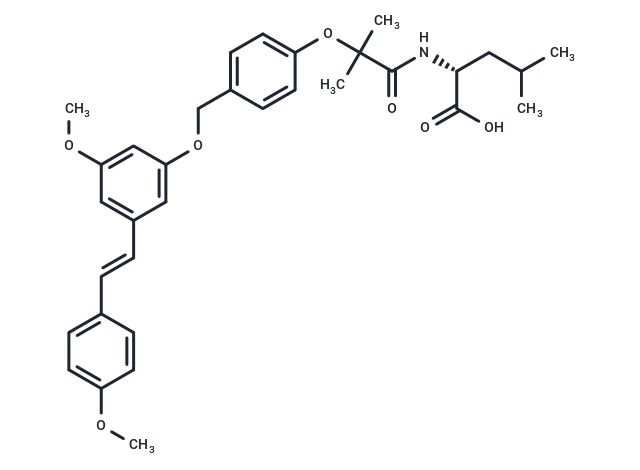Shopping Cart
Remove All Your shopping cart is currently empty
Your shopping cart is currently empty
ABP/PPAR modulator 1 is an orally active multi-regulator of FABP and PPAR, exhibiting IC50 values of 0.65 μM for FABP1 and 1.08 μM for FABP4, and EC50 values of 9.19 μM, 2.20 μM, and 1.58 μM for PPARα, PPARγ, and PPARδ, respectively. It demonstrates potent activity against metabolic dysfunction-associated steatohepatitis (MASH). Additionally, ABP/PPAR modulator 1 dose-dependently improves various pathological features of fatty liver in a WD + Carbon tetrachloride-induced MASH mouse model.

| Pack Size | Price | USA Warehouse | Global Warehouse | Quantity |
|---|---|---|---|---|
| 10 mg | Inquiry | Backorder | Backorder | |
| 50 mg | Inquiry | Backorder | Backorder |
| Description | ABP/PPAR modulator 1 is an orally active multi-regulator of FABP and PPAR, exhibiting IC50 values of 0.65 μM for FABP1 and 1.08 μM for FABP4, and EC50 values of 9.19 μM, 2.20 μM, and 1.58 μM for PPARα, PPARγ, and PPARδ, respectively. It demonstrates potent activity against metabolic dysfunction-associated steatohepatitis (MASH). Additionally, ABP/PPAR modulator 1 dose-dependently improves various pathological features of fatty liver in a WD + Carbon tetrachloride-induced MASH mouse model. |
| Targets&IC50 | PPARα:9.19 μM(EC50) |
| In vitro | ABP/PPAR modulator 1 (Compound 27) exhibits excellent binding affinity for PPAR receptors, with dissociation constants (K d) of 5.23 μM for PPARα, 0.98 μM for PPARγ, and 0.76 μM for PPARδ. Additionally, ABP/PPAR modulator 1 (10 mM-0.1 μM) shows a higher affinity for FABP1 compared to its endogenous ligand linoleic acid (LA), with K d values of 5.885 μM versus 14.281 μM, respectively. |
| In vivo | ABP/PPAR modulator 1 (Compound 27), administered orally at doses between 5-20 mg/kg once daily for 4 weeks, demonstrates a dose-dependent reduction in liver weight, liver-to-body weight ratio, and NAS score in MASH mice induced by a Western diet with low-dose Carbon tetrachloride (CCl4) [WD + Carbon tetrachloride]. It suppresses inflammation, mitigates fibrosis, and alleviates oxidative stress, with increased effectiveness against MASH at higher doses. Specifically, ABP/PPAR modulator 1 at 20 mg/kg reduces TC and liver TG levels in the MASH mouse model. At 10 mg/kg, it significantly lowers liver LDH, serum AST, ALT, TBA, and TBIL levels without affecting ALP levels. |
| Molecular Weight | 561.67 |
| Formula | C33H39NO7 |
| Storage | Powder: -20°C for 3 years | In solvent: -80°C for 1 year | Shipping with blue ice/Shipping at ambient temperature. |
| Size | Quantity | Unit Price | Amount | Operation |
|---|

Copyright © 2015-2025 TargetMol Chemicals Inc. All Rights Reserved.